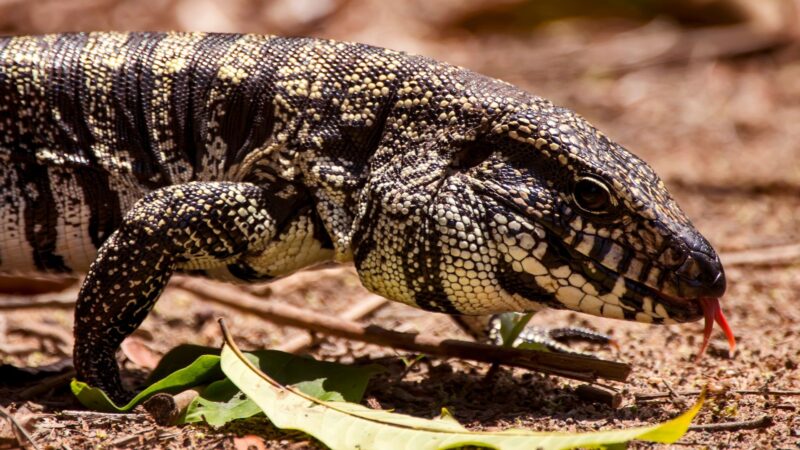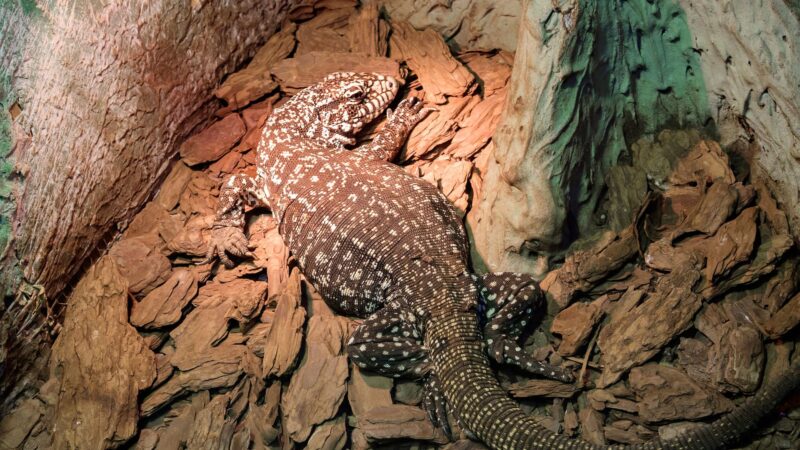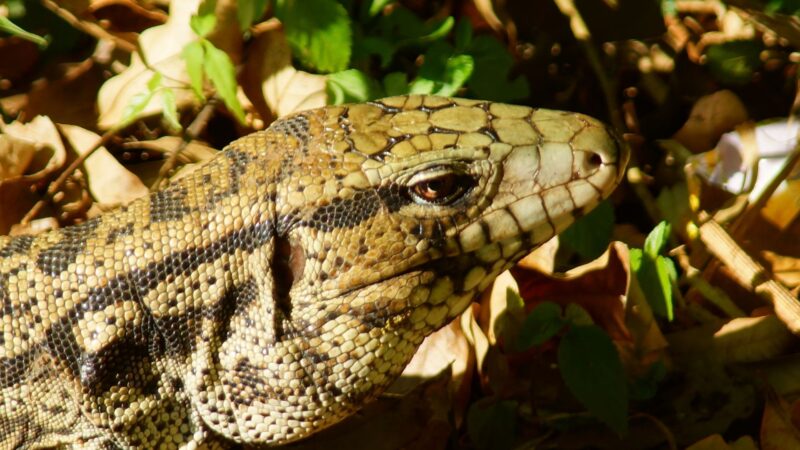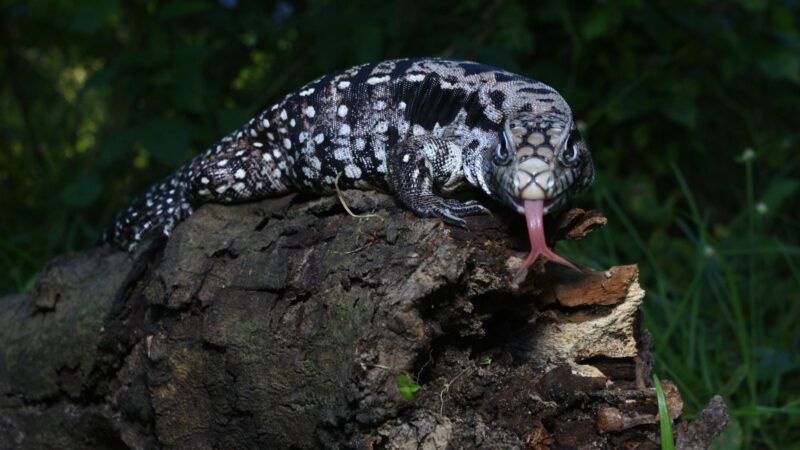Known for their sheer large size, Argentine black and white tegus are usually kept as pets due to their docile nature and intelligence. However, this South American native can become both a nuisance and a threat.
So, how to get rid of Argentine black and white tegus? Do so by setting up traps, monitoring their presence, removing attractants, minimizing potential burrowing areas, spreading awareness, and discouraging owners from releasing their pet tegus.
This comprehensive guide discusses everything you need to know about Argentine black and white tegus, their appearance and characteristics, and how to properly get rid of them. Read further for more!

Argentine Black and White Tegus Appearance
Characterized by their sheer size, Argentine black and white tegus (Salvator meriane) is the largest lizard in the entire Western Hemisphere.
They have sleek bodies with thick necks, narrow heads, and large jowls. They differ from other tegu species by their distinctive black base coloration on their bodies. They also have dark bands and light spots on their scales.
Argentine black and white tegus usually grow 4 to 5 feet long and weigh as heavy as 18 pounds. Females are significantly smaller, reaching only up to 3.5 feet.
Argentine Black and White Tegus Diet
Argentine black and white tegus are opportunistic omnivores with red, fleshy forked tongues that are used to detect and differentiate between food and nonfood smells.
Their diets primarily consist of fruits and other plant matter, invertebrates, other reptiles, small mammals, and amphibians.
In captivity, these tegus tend to be picky with food and prefer following a carnivorous diet consisting of fish, rodents, insects, and eggs. They are even known to consume alligator eggs.
Related: What Do Backyard Lizards Eat? | Information and Facts
Argentine Black and White Tegus Evolution
Argentine black and white tegus have evolved to adapt well to their environments. They are now able to hibernate to keep their body temperatures warm during the late fall to winter months.
Due to this, they may expand their distribution in the United States, invading even more regions outside of their native ranges.
Argentine Black and White Tegus Behavior and Temperament
Argentine black and white tegus are popular in pet trades, partly because of their relatively docile nature and intelligence. They are also unusually active during the day compared to other lizards and are excellent swimmers.
Argentine Black and White Tegus Habitat
These tegus thrive in savannas, dry uplands with sandy soil, and disturbed habitats. They prefer areas that have a coldest average temperature ranging between 41°F to 59°F.
Related: How to Get Rid of Brown Anole Lizards Naturally | Essential Tips!
Argentine Black and White Tegus Reproduction
Argentine black and white tegus begin searching for mates after hibernating for 5 to 6 months. This is because male testosterone levels are at an all time high, leading to an increase in aggressive and territorial behaviors as well.
Females construct nests inside their burrows and begin laying eggs in the spring season. They can produce an average of 30 eggs per clutch in 2 clutches a year.
During the reproductive season, tegus have a special ability to take advantage of their slow metabolism to give off heat and maintain body temperatures.
Argentine Black and White Tegus Lifespan
They have a lifespan of 10 to 12 years in the wild and 15 to 20 years in captivity.
Related: How to Get Rid of Mediterranean House Geckos | Simple Solutions for Quick Removal
Where Can You Find Argentine Black and White Tegus Today?

Due to intensive pet trade activities over the last 10 to 15 years, this tegu species has extended its range from South America to the Southeastern United States such as South Carolina, Florida, Alabama, and Georgia.
Are Argentine Black and White Tegus Poisonous?
No. Although they may resort to biting humans, they do not release any poison into the bloodstream. Nonetheless, tegu bites are painful and can cause tissue and bone damage that may take up to 6 weeks of healing.
Facts About Argentine Black and White Tegus

Aside from the information mentioned earlier, here are more facts you can learn about Argentine black and white tegus:
- Prolific breeders: Evidence of this is shown in the fact that 1,400 tegus were captured in Florida in 2019. This indicates that breeding colonies may exist.
- Eats protected species: Argentine black and white tegus are capable of consuming the eggs of other animals. This includes vulnerable species such as the American crocodile and the gopher tortoise.
Are Argentine Black and White Tegus Good Pets?
Can You Train Tegus?
Yes. Argentine black and white tegus can be trained to perform some basic tasks such as walking to or staying on a specific spot, responding when being called by name, wearing a harness, and going to designated “bathrooms.”
The usual motivators being used to train these lizards are food. But other devices such as clickers are also used.
Are Argentine Black and White Tegus Aggressive?

Yes, usually right after hibernation. Interestingly, Argentine black and white tegus show a significant relationship between size and bite force with their flight or fight mechanism.
That is, the larger the size and higher the bite force, the slower they tend to move. In other words, these tegus will have lesser escape responses.
Aside from biting, tegus also whip or swipe their tails when they feel threatened. Like many lizard species, they may cut off and drop a part of their tail in an attempt to escape predators.
Argentine Black and White Tegu Predators and Threats
Known predators of Argentine black and white tegus are jaguars, cougars, caimans, otters, snakes, and birds of prey. Aside from this, illegal pet trade and habitat loss may serve as threats to their survival.
How to Get Rid of Argentine Black and White Tegus?
It is important to know that Argentine black and white tegus are a nuisance. They can threaten local biodiversity, cause property damage due to their burrowing habits, and harm humans and other animals.
Here are effective ways of getting rid of lizards and preventing them from coming back:
- Establishing targeted traps with the appropriate baits. Contact a local wildlife expert on how to properly set them up.
- Help your local state tegu programs by regularly monitoring areas for their presence and immediately reporting any sightings.
- Remove attractants such as food and water to keep them out of your property.
- Observe cleanliness and orderliness of yards or lawns to minimize potential burrowing and hiding areas.
- Spread awareness on the importance of keeping invasive animals such as tegus in check.
- Discourage tegu owners from releasing their pet tegus into the wild. They should surrender it to state wildlife authorities instead.
Related: 9 Best Lizard Repellents That Actually Work | A Detailed Guide
List of Sources
Florida Fish and Wildlife Conservation Commission. (n.d.). Argentine Black and White Tegu.
Haddad Jr., V., Duarte, M. R., & Neto, D. G. (2008). Tegu (teiu) bite: report of human injury caused by a Teiidae lizard.
Haley, J. (2022). The Relationship between People and the Tegu: A Review of the Literature.
Harvey, R. G., Dalaba, J. R., Ketterlin, J., Roybal, A., Quinn, D., & Mazzotti, F. J. (2021). Growth and Spread of the Argentine Black and White Tegu Population in Florida.
McGarrity, M. E., & Johnson, S. A. (2022). Florida Invader: Tegu Lizard.
- How to Get Rid of Turtles | Proven Long-Term Solutions! - August 26, 2023
- How to Get Rid of Kingsnakes | Easy & Humane! - August 26, 2023
- How to Get Rid of Northern Water Snakes | Best Solutions and Preventative Measures! - August 19, 2023
